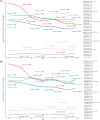Global trends in heart failure from 1990 to 2019: An age-period-cohort analysis from the Global Burden of Disease study
- PMID: 38937863
- PMCID: PMC11424301
- DOI: 10.1002/ehf2.14915
Global trends in heart failure from 1990 to 2019: An age-period-cohort analysis from the Global Burden of Disease study
Abstract
Aims: This study aimed to analyse the global prevalence and disability trends of heart failure (HF) from 1990 to 2019, considering both sexes and country-specific economic strata.
Methods: This study conducted a secondary analysis employing data from the Global Burden of Disease (GBD) study. The analysis is stratified by sex and Socio-demographic Index (SDI) levels. Through age-period-cohort and Joinpoint regression analyses, we investigated the temporal trends in HF prevalence and years lived with disability (YLDs) during this period.
Results: Between 1990 and 2019, the global prevalence of HF surged by 106.3% (95% uncertainty interval: 99.3% to 114.3%), reaching 56.2 million cases in 2019. While all-age prevalence and YLDs increased over the 30 year span, age-standardized rates decreased by 2019. Countries with higher SDI experienced a more pronounced percentage decrease compared with those with lower SDI. Longitudinal analysis revealed an overall improvement in both prevalence and YLDs for HF, albeit with notable disparities between SDI quintiles and sexes. Ischaemic heart disease and hypertensive heart disease emerged as the most rapidly increasing and primarily contributing causes of HF, albeit with variations observed across different countries. The average annual percentage change for prevalence and YLDs over the period was -0.26% and -0.25%, respectively.
Conclusions: This study offers valuable insights into the global burden of HF, considering factors such as population aging, regional disparities, sex differences and aetiological variations. The findings hold significant implications for healthcare planning and resource allocation. Continued assessment of these trends and innovative strategies for HF prevention and management are crucial for addressing this pressing global health concern.
Keywords: Global Burden of Disease study; age‐period‐cohort analysis; heart failure; prevalence; years lived with disability.
© 2024 The Author(s). ESC Heart Failure published by John Wiley & Sons Ltd on behalf of European Society of Cardiology.
Conflict of interest statement
The authors declare no conflicts of interest.
Figures





Similar articles
-
Global, regional, and national time trends in incidence, prevalence, years lived with disability for uterine fibroids, 1990-2019: an age-period-cohort analysis for the global burden of disease 2019 study.BMC Public Health. 2023 May 19;23(1):916. doi: 10.1186/s12889-023-15765-x. BMC Public Health. 2023. PMID: 37208621 Free PMC article.
-
Global, regional, and national burdens of heart failure in adolescents and young adults aged 10-24 years from 1990 to 2021: an analysis of data from the Global Burden of Disease Study 2021.EClinicalMedicine. 2024 Dec 9;79:102998. doi: 10.1016/j.eclinm.2024.102998. eCollection 2025 Jan. EClinicalMedicine. 2024. PMID: 39737218 Free PMC article.
-
The global burden of heart failure attributable to interstitial lung diseases: insights from the global burden of disease study 2021.BMC Cardiovasc Disord. 2025 Apr 7;25(1):262. doi: 10.1186/s12872-025-04702-y. BMC Cardiovasc Disord. 2025. PMID: 40189529 Free PMC article.
-
The global, regional, and national burden of pancreatitis in 195 countries and territories, 1990-2017: a systematic analysis for the Global Burden of Disease Study 2017.BMC Med. 2020 Dec 10;18(1):388. doi: 10.1186/s12916-020-01859-5. BMC Med. 2020. PMID: 33298026 Free PMC article.
-
Global, regional, and national burden of 12 mental disorders in 204 countries and territories, 1990-2019: a systematic analysis for the Global Burden of Disease Study 2019.Lancet Psychiatry. 2022 Feb;9(2):137-150. doi: 10.1016/S2215-0366(21)00395-3. Epub 2022 Jan 10. Lancet Psychiatry. 2022. PMID: 35026139 Free PMC article.
Cited by
-
Mediating role of inflammatory indicators in the association between sleep status and blood pressure in centenarians: evidence from China Hainan Centenarian Cohort Study.J Geriatr Cardiol. 2024 Sep 28;21(9):874-883. doi: 10.26599/1671-5411.2024.09.009. J Geriatr Cardiol. 2024. PMID: 39483268 Free PMC article.
-
Trends in Avoidable Hospitalizations for Heart Failure in Switzerland (1998-2018): A Cross-Sectional Analysis.Healthcare (Basel). 2024 Dec 17;12(24):2547. doi: 10.3390/healthcare12242547. Healthcare (Basel). 2024. PMID: 39765974 Free PMC article.
-
Prediction of three-year all-cause mortality in patients with heart failure and atrial fibrillation using the CatBoost model.BMC Cardiovasc Disord. 2025 Jul 4;25(1):466. doi: 10.1186/s12872-025-04928-w. BMC Cardiovasc Disord. 2025. PMID: 40615809 Free PMC article.
-
The novel triglyceride‒glucose-weighted adjusted waist index as a supplementary diagnostic tool for heart failure: evidence of improved reclassification beyond traditional TyG-related indices from a cross-sectional study.Cardiovasc Diabetol. 2025 Aug 12;24(1):329. doi: 10.1186/s12933-025-02896-1. Cardiovasc Diabetol. 2025. PMID: 40797254 Free PMC article.
-
ITACARE-P/SIGG/SIGOT/SICGE position paper on elderly cardiac patient referral to cardiac rehabilitation.Int J Cardiol Cardiovasc Risk Prev. 2025 Jul 1;26:200454. doi: 10.1016/j.ijcrp.2025.200454. eCollection 2025 Sep. Int J Cardiol Cardiovasc Risk Prev. 2025. PMID: 40686727 Free PMC article.
References
Publication types
MeSH terms
Grants and funding
- 2022-GSP-GG-18/National High Level Hospital Clinical Research Funding
- 2023-GSP-RC-04/National High Level Hospital Clinical Research Funding
- 2023-GSP-RC-17/National High Level Hospital Clinical Research Funding
- 2023-GSP-QN-28/National High Level Hospital Clinical Research Funding
- 2021-I2M-1-065/CAMS Innovation Fund for Medical Sciences
LinkOut - more resources
Full Text Sources
Medical
Research Materials
Miscellaneous

